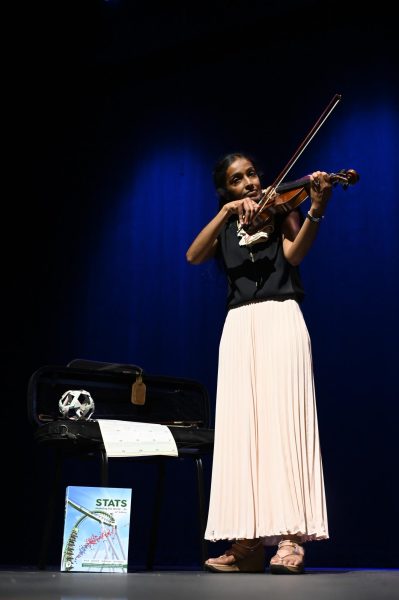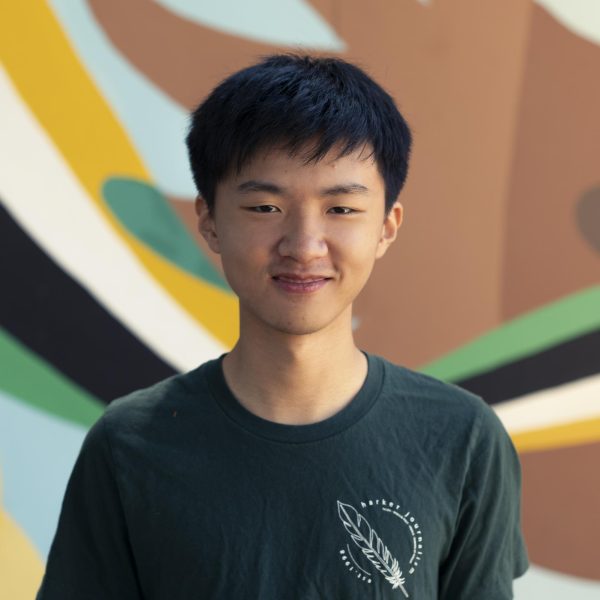
Listen to a violin sonata for long enough, and you might just hear an unexpected motif — Fibonacci. In notes, chords and arpeggios alike, the golden ratio dictates classical harmony, interweaving music within a long-standing history of mathematics. Almost 800 years later, mathematicians and musicians still find refuge in these technical and artistic works. Math teacher Anu Aiyer is no different. Meet Dr. Aiyer: violinist, classical Indian singer and lifelong learner.
For Dr. Aiyer, music has always been a mainstay in her life. Growing up in India, she often heard her parents play Indian classical songs, a sound that has become synonymous with the feeling of home. When she moved to Las Cruces, New Mexico at the age of 12, music came with her. In each new addition to her repertoire, Dr. Aiyer gained insight into the world around her.
“When I’m learning a new piece, in the beginning it’s challenging because it’s new,” Dr. Aiyer said. “The other aspect is that you learn a little bit about the history of either the composer, or for Indian music, what the song is, the message that it’s trying to convey. It’s always appealing.”
Dr. Aiyer picked up the violin in middle school, a prelude to her musical journey to come. While grappling with learning English and finding community in her new home, it was through violin that she found joy. Within the universal language of music, she could express herself, capturing both abstract ideals and emotions.
When Dr. Aiyer attended graduate school at Stanford, she discovered new forms of music. It was there that a coincidental encounter with an Indian classical singing instructor allowed her to reconnect with her cultural heritage. The art of Indian classical singing relies on an oral learning style, where an experienced singer repeats segments of a song for students to memorize. The practice’s strong reliance on student-teacher interactions allows for Dr. Aiyer to reflect on her own teaching.
“Every class, you don’t learn very much because there’s only so much you can put in memory,” Dr. Aiyer said. “For my Indian classical music, I still go for lessons and that’s very helpful, because I’m in the student position at least once a week.”
As she took on other commitments, Dr. Aiyer stepped away from music for over twenty years. In the meantime, Dr. Aiyer embraced her more technical interests, like math and engineering.
“Physics and math put together gave me the path of electrical engineering,” Dr. Aiyer said. “When I came to grad school, the field that I got into was more mathematical in nature, like signal processing. So even though I’d taken a lot of math for engineering, when I came to grad school, I took even more math. That’s when the math thing came into being.”
When Dr. Aiyer later came to teach at Harker, it was the orchestra that rekindled her love for music, both violin and singing.
“I would come listen to the orchestra and think, ‘I remember that’ or ‘I recognize that’ or ‘I want to play that,’” Dr. Aiyer said. “And so it took 10 years, but I would see the students play, and then I said, ‘Oh, you know what, I should just pick it up again and see.’”
The expressive nature of music complements Dr. Aiyer’s focus in the technical sciences. After a foray in industry as a software engineer, Dr. Aiyer eventually came into teaching, hoping to bring those same subjects to curious students.
“My first impression of her was that she was enthusiastic and engaging,” mathematics department chair and colleague Anthony Silk said. “When I became department chair, one of the first things she told me was that she wanted to teach every single math course that Harker offers.”
Dr. Aiyer entered teaching to help each student find their own path. Growing up as one of two Indian families in her community, Dr. Aiyer credits her previous teachers for guiding her through difficult times. In her classes, she seeks to similarly support each student she works with.
“When I had to figure out what class I should take, it was really my teachers who said, ‘You should really be in this class and you should be in that class,’” Dr. Aiyer said. “There were a lot of teachers who took it upon themselves to make sure I felt comfortable fitting in. I didn’t realize how much of an impact that made till much later.”
Three years ago, inspired by Assistant Upper School Division Head Kelly Horan, Dr. Aiyer began leading Link Crew, the advisory program that connects underclassmen advisories with junior and senior representatives.
“I would say she’s one of the role models I want students to use as an adult,” Horan said. “She is intellectually curious, she challenges herself in different ways, but she also is grounded in family, health, exercise and prioritizing well-being.”
Inspired by the many mentors in her life, Dr. Aiyer became an educator herself, imparting the same lessons to her students. Whether it be in music, mathematics or elsewhere, Dr. Aiyer cherishes her opportunity to continue learning, discovering new harmonies in the tune of her life.




![LALC Vice President of External Affairs Raeanne Li (11) explains the International Phonetic Alphabet to attendees. "We decided to have more fun topics this year instead of just talking about the same things every year so our older members can also [enjoy],” Raeanne said.](https://harkeraquila.com/wp-content/uploads/2025/10/DSC_4627-1200x795.jpg)


















![“[Building nerf blasters] became this outlet of creativity for me that hasn't been matched by anything else. The process [of] making a build complete to your desire is such a painstakingly difficult process, but I've had to learn from [the skills needed from] soldering to proper painting. There's so many different options for everything, if you think about it, it exists. The best part is [that] if it doesn't exist, you can build it yourself," Ishaan Parate said.](https://harkeraquila.com/wp-content/uploads/2022/08/DSC_8149-900x604.jpg)




![“When I came into high school, I was ready to be a follower. But DECA was a game changer for me. It helped me overcome my fear of public speaking, and it's played such a major role in who I've become today. To be able to successfully lead a chapter of 150 students, an officer team and be one of the upperclassmen I once really admired is something I'm [really] proud of,” Anvitha Tummala ('21) said.](https://harkeraquila.com/wp-content/uploads/2021/07/Screen-Shot-2021-07-25-at-9.50.05-AM-900x594.png)







![“I think getting up in the morning and having a sense of purpose [is exciting]. I think without a certain amount of drive, life is kind of obsolete and mundane, and I think having that every single day is what makes each day unique and kind of makes life exciting,” Neymika Jain (12) said.](https://harkeraquila.com/wp-content/uploads/2017/06/Screen-Shot-2017-06-03-at-4.54.16-PM.png)








![“My slogan is ‘slow feet, don’t eat, and I’m hungry.’ You need to run fast to get where you are–you aren't going to get those championships if you aren't fast,” Angel Cervantes (12) said. “I want to do well in school on my tests and in track and win championships for my team. I live by that, [and] I can do that anywhere: in the classroom or on the field.”](https://harkeraquila.com/wp-content/uploads/2018/06/DSC5146-900x601.jpg)
![“[Volleyball has] taught me how to fall correctly, and another thing it taught is that you don’t have to be the best at something to be good at it. If you just hit the ball in a smart way, then it still scores points and you’re good at it. You could be a background player and still make a much bigger impact on the team than you would think,” Anya Gert (’20) said.](https://harkeraquila.com/wp-content/uploads/2020/06/AnnaGert_JinTuan_HoHPhotoEdited-600x900.jpeg)

![“I'm not nearly there yet, but [my confidence has] definitely been getting better since I was pretty shy and timid coming into Harker my freshman year. I know that there's a lot of people that are really confident in what they do, and I really admire them. Everyone's so driven and that has really pushed me to kind of try to find my own place in high school and be more confident,” Alyssa Huang (’20) said.](https://harkeraquila.com/wp-content/uploads/2020/06/AlyssaHuang_EmilyChen_HoHPhoto-900x749.jpeg)



